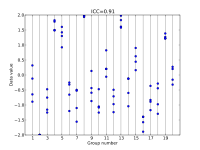
Photo from wikipedia
Observation-based risk assessments are often used for evaluation of biomechanical workload and the condition of the workplace ergonomics. However, the inter- and intra-rater reliability of the methods used for the… Click to show full abstract
Observation-based risk assessments are often used for evaluation of biomechanical workload and the condition of the workplace ergonomics. However, the inter- and intra-rater reliability of the methods used for the assessments are insufficiently studied. The OCRA checklist method, included as a reference method in the ISO and CEN standards regarding upper limb repetitive risk assessment, was in this study investigated regarding its reliability. Eleven ergonomists were educated within the method. Each ergonomist risk-assessed ten video-recorded manual work tasks, on two occasions. The average inter-rater agreement of the five overall risk levels was 39% and the linearly weighted kappa was 0.43, the intra-rater dittos were 45% and 0.52. Both indicating a moderate reliability, but lower than what could be expected. The levels might be sufficient for coarse surveys. However, for risk assessments before and after an intervention, complementing technical methods should be considered.
Journal Title: Applied ergonomics
Year Published: 2020
Link to full text (if available)
Share on Social Media: Sign Up to like & get
recommendations!